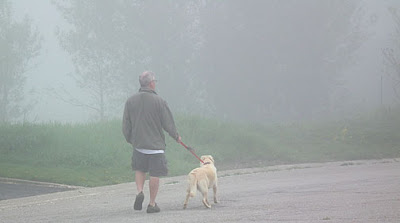 |
| Shelters allow visitors to relax, sip a coffee and enjoy each other's company. |
"Life is Good!" at
Winter Wheat.
 |
| "Life is Good!" |
Winter Wheat is the inviting home of Canadian folk artist Lucy Ogletree and her husband Mike Roberts. The five-acre property, filled with whimsical art, is open to the public for much of the year. Check the website before going. The grounds and shop make a perfect destination to explain a drive in the country.
According to the Winter Wheat site:
"
Folk Art is created by ordinary folks who express what they are feeling in their hearts by creating imaginative things. Often times the expressions they create are extremely exuberant, witty or humorous."
 |
| Morgans leaving the parking lot in Sparta, Ontario, Sunday. |
Sunday the group of Morgans touring Southwestern Ontario stopped in Sparta, the village just north of Winter Wheat. They proceeded down Quaker Road to Ogletree's oasis of creativity. The group, mainly from the Toronto area, was impressed.
To reach Winter Wheat, take 401-exit-177 and head in a southerly direction on Hwy 4 towards St. Thomas. At the edge of St. Thomas, turn right, staying on Hwy 4, now also known as Sunset Road. Turn left at Union and head east on Sparta Road. In Sparta, turn right onto Quaker Road and head south for about 2 km. Winter Wheat is on the west side of the road. Watch for the property dense with trees and the fence posts decorated with angels.
 |
| Winter Wheat is an amazingly welcoming place. |
Ogletree's studio and her home are nestled among the tall pines and spruce trees, along with a country store filled with her beautiful folk art paintings and whimsical creations.
Visitors are encouraged to not only stroll the store but to wander the grounds. There are a couple of shelters where one can relax with a coffee and some friends.
The sculptures dotting the property are brightly coloured with a whimsical, upbeat quality. For Ogletree, everything is art. Brooms? Art! Funnels? Art! Keys? Art! . . .
The richness of Winter Wheat means everyone has a slightly different reaction to the place. I find the spot inspiring. I wander her gardens, stroll down her flower-bordered paths and smile at the merriment added by her sculptures. It all leaves me wanting to do something with my yard. So many times backyards are nothing more than a barren, sterile patch of grass.
The easiest answer is to buy some of the yard sculpture for sale at Winter Wheat. Mix some Ogletree sculptures with your day lilies and when the blooms are done, the sculptures will continue to brighten your garden.


















































